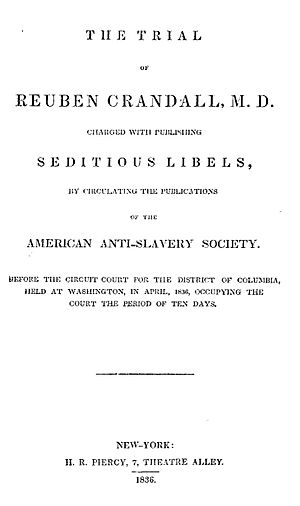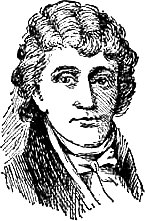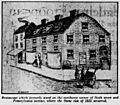Trial of Reuben Crandall facts for kids
Quick facts for kids
Reuben Crandall
|
|
|---|---|
| Born | January 6, 1806 |
| Died | January 17, 1838 (aged 32) |
| Occupation | Physician and lecturer on botany |
| Known for | Arrest, trial, and acquittal on sedition charges |
| Relatives | Prudence Crandall, sister |
Reuben Crandall (born January 6, 1806 – died January 17, 1838) was a doctor and the younger brother of famous educator Prudence Crandall. He was arrested in Washington, D.C., on August 10, 1835. The charge was "spreading ideas that could cause trouble and encourage enslaved people and free Black people to revolt." These ideas came from materials that showed American slavery as cruel and wrong.
A angry crowd almost killed him, but the mayor called out the local army (militia) to protect him. This event led to the Snow Riot, a period of unrest in the city. Even though a jury later found him innocent, he had to stay in a Washington jail for almost eight months. This was because his bail (money needed to be released) was set very high. While in jail, he caught tuberculosis, a serious lung disease. He died soon after he was released.
This was the first trial for "sedition" (trying to cause a rebellion against the government) in the United States. The Federal District Attorney, Francis Scott Key, said it was "one of the most important cases ever tried here." Crandall's time in jail, his trial, and his acquittal (being found not guilty) helped more people support the movement to end slavery. Many newspapers felt sorry for him. The New York Evangelist newspaper said his case was "one of the most unfair that ever happened in this country."
Francis Scott Key was very involved in this whole situation. He was the one who had Crandall arrested and convinced a judge to keep him in jail without bail. Key also prepared a very long list of charges against Crandall. The "not guilty" verdict was embarrassing for Key and ended his political career.
Contents
About Reuben Crandall's Life

Reuben Crandall was born around 1805. His parents, Pardon and Esther Carpenter Crandall, were Quakers. They lived in Carpenter's Mills, Rhode Island. Reuben had an older sister, Prudence, and two other siblings, Hezekiah and Almyra.
When Reuben was about 8 years old, his family moved to Canterbury, Connecticut. He studied at Yale College for a year. After that, he studied medicine with a doctor in Philadelphia. He then moved to Peekskill, New York, where he worked as a doctor for seven years. He was not married and was the secretary of the local group that wanted people to drink less alcohol.
Crandall lived with a family in Peekskill and was also their doctor. Because of their health problems, they asked him to go with them on a trip to Washington, D.C. After seeing Washington, he decided to stay there. He brought his things from Peekskill and opened a doctor's office in Georgetown. However, he soon became too sick to continue working as a doctor. He then started earning money by giving lectures about his special interest, botany (the study of plants).
Why This Case Was Important
In 1835, the United States was very divided over slavery. After Nat Turner's revolt in 1831, people in the slave states were very worried about more slave uprisings. At the same time, the movement to end slavery, called abolitionism, grew very quickly.
The American Anti-Slavery Society was started in 1833. Its leaders, like Wm. Lloyd Garrison, believed that sending free Black people to Africa was not the answer. They trained people to travel and speak about ending slavery across the Northern states. Many local anti-slavery groups were formed. In 1835 alone, the number of these groups grew from 150 to 350.
In July 1835, the American Anti-Slavery Society sent over 175,000 anti-slavery writings to leaders across the country. Around this time, Amos Dresser was publicly whipped in Nashville, Tennessee, for having anti-slavery papers. The Noyes Academy in Canaan, New Hampshire, was destroyed for letting Black students attend. In Charleston, South Carolina, a mob broke into the Post Office and publicly burned anti-slavery mail. Both President Andrew Jackson and the Postmaster General supported Southern postmasters who refused to deliver such mail.
Reuben Crandall's Arrest
Reuben Crandall was arrested on August 10, 1835. He was accused of "spreading ideas that could cause trouble and encouraging enslaved people and free Black people to revolt." The city was already very tense and angry. Officials were afraid to take Crandall out of jail for his first court appearance, so a judge came to the jail instead.
Afterward, an angry crowd tried to break into the jail to harm Crandall. But the mayor, William A. Bradley, called out the local army (militia) to protect him. Some reports say Marines also helped. They surrounded City Hall, where the jail was, and saved Crandall. However, the rest of the city was left without protection.
The crowd, unable to get to Crandall, looked for other targets. They attacked an elegant restaurant owned by a free Black man named Beverly Snow. They destroyed the furniture and drank all the alcohol. Then, they damaged several churches belonging to free Black communities. They also burned a house and some apartments where Black people lived. Angry crowds continued to scare Black neighborhoods in Washington for the rest of the week. This whole event is known as the Snow Riot.
Crandall was first denied bail, meaning he could not leave jail. In January, his lawyers were able to get a bail hearing. His bail was set at $5,000, which was a very large sum of money at the time. He could not pay it, so he stayed in jail.
The Trial Begins
The trial, called United States v. Crandall, began on April 15, 1836, and lasted ten days. It was the most talked-about trial in Washington in many years. It was also the first time anyone had been tried for sedition in the United States. The courtroom was packed with people, including several members of Congress. Three newspaper reporters were there to cover the story.
A much smaller trial of Amos Dresser, who was whipped for having anti-slavery writings, happened two weeks before Crandall's. But Crandall's trial was in the nation's capital, so it received national attention. Many people thought that someone had finally caught an abolitionist who was telling enslaved people to revolt. This was the first trial in the country for the crime of "publishing harmful writings, intending to cause trouble and rebellion among enslaved and free Black people." Francis Scott Key wanted to blame the Snow Riot on Crandall and his "wicked writings."
During the trial, a newspaper described Crandall as "quite pale." This was likely because he had been held for "eight months in our close and unhealthy prison."
The main lawyer for the prosecution was Francis Scott Key, who was the District Attorney for the District of Columbia. Key owned enslaved people and supported sending free Black people to Africa. Crandall was defended by two of Washington's best lawyers, Richard Coxe and Joseph Bradley. These lawyers were very skilled and challenged Key's arguments at every step.
Key wrote the very long list of charges himself. There were five main accusations. The first four described writings that Crandall was accused of publishing. The fifth charge was about him distributing these "harmful writings."
Choosing the jury took a long time. Many possible jurors already knew about the case and had decided if Crandall was guilty or innocent.
What the Prosecution Said
The prosecutors claimed that Crandall not only had anti-slavery writings but had also published (distributed) them. They said he did this to cause a rebellion among the enslaved people of the District of Columbia. The prosecution finished presenting their case on April 22.
What the Defense Said
Crandall's lawyers argued that he had only lent one copy of one item to someone who asked for it. They said that one copy was not "publishing," and just having the writings was not the same as publishing them. The writings in question had been used as packing material for his medical tools. The woman of the family he stayed with in Peekskill said the writings had been in her attic. She herself used them to pack Dr. Crandall's belongings.
Several witnesses from Peekskill, including the sheriff of Westchester County, said that Crandall had shown no interest in the issue of slavery during his years there. Also, a well-known supporter of sending free Black people to Africa, Andrew T. Judson, testified. He said that Reuben had actively opposed his sister Prudence's plan to run a school for Black girls. Finally, it was revealed that Reuben Crandall, who was not an abolitionist, had been confused with Phineas Crandall. Phineas Crandall was on the board of the American Anti-Slavery Society and had mistakenly been said to be from Peekskill.
All the witnesses said that Crandall was a good person. A report in the Boston Courier newspaper said his "character is clear and highly respected."
The Trial's Result
After three hours, the jury made a strong statement against Key. They found Crandall not guilty right away. This acquittal made headlines across the country. The Boston Courier reporter wrote, "I believe there is a feeling in this community of sympathy for him, and regret for his eight months imprisonment. There is much to answer for somewhere." However, Crandall chose not to sue for being wrongly imprisoned, even though his father suggested it.
For his safety, Crandall stayed in jail for a short time after the trial. His friends then secretly helped him leave town. He went to his parents' house in Connecticut, hoping to get better from the "consumption" (tuberculosis) he caught in jail. In late 1836, he moved to Jamaica, hoping the warm weather would help him recover. However, he died in Kingston, Jamaica, on January 17, 1838.
After the trial, Key was no longer a close advisor to the president. He "seemed to have lost his ambition."
Images for kids






